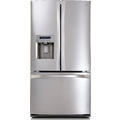Documents: Go to download!
- Owner's manual - (English)
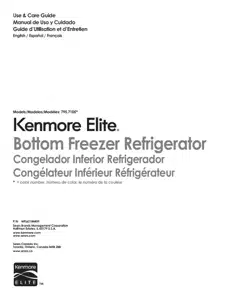
- PARTS AND FEATURES
- USING YOUR REFRIGERATOR
- FILTER
- CARE AND CLEANING
- TROUBLESHOOTING GUIDE
Table of contents
Owner 's Guide for Refrigerator
PARTS AND FEATURES
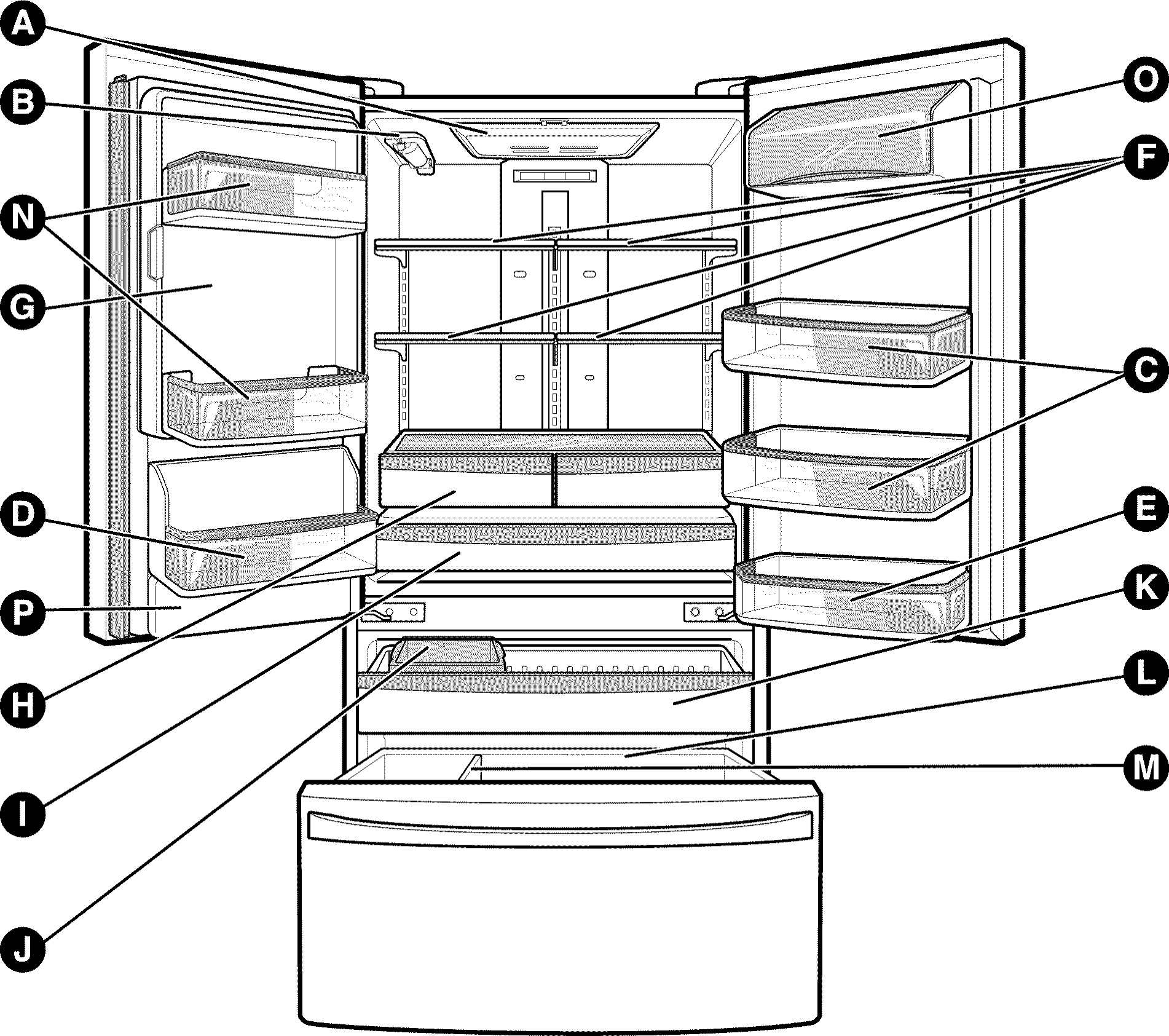
Use this page to become more familiar with the parts and features. Page references are included for your convenience.
NOTE: This guide covers several different models. The refrigerator you have purchased may have some or all of the items listed below. The locations of the features shown below may not match your model.
A. Refrigerator Light (p. 32)
B. Filter (Inside) (p. 28)
C. Modular Door Bins (p. 26)
D. Fixed Door Bin
E. Fixed Door Bin
F. Refrigerator Shelves (p. 24)
G. Ice Room (p. 20)(Ice Maker and Ice Bin)
H. Humidity Controlled Crisper (p. 25)
I. Temperature Controlled Pantry Drawer (p. 25)
J. Extra Ice Bin (p. 26)
K. Pullout Drawer (p. 27)
L. Durabase (p. 27)
M. Divider (p. 27)
N. Door Bins
O. Dairy Bin (p. 26)
P. Water Tank Cover
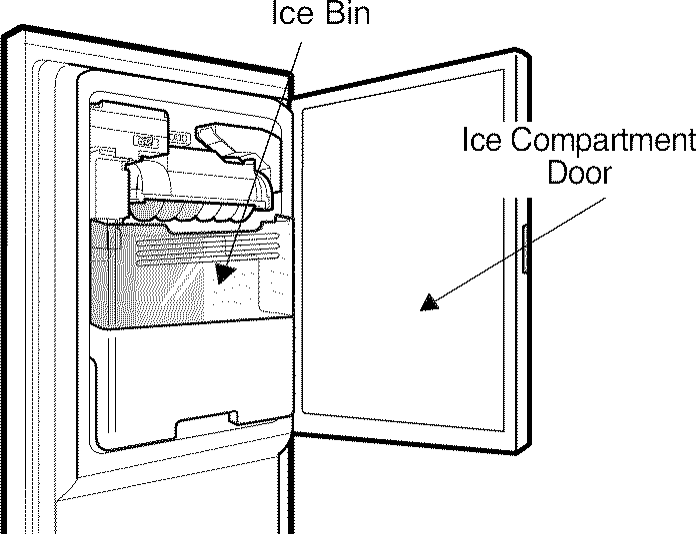
USING YOUR REFRIGERATOR
SETTING THE CONTROLS
Temperature
- The refrigerator control is preset at 37°F (3°C) and the freezer control is preset at 0°F (-18°C). These are the recommended temperature settings for normal use and conditions. Wait 24 hours for the refrigerator and freezer to reach these temperatures.
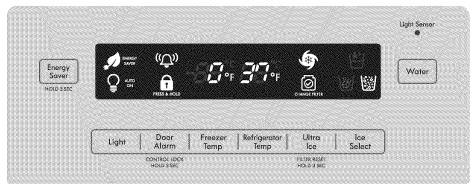
- The Refrigerator Temp Control range is from 33°F to 46°F (1°C to 8°C). The lower the number setting, the colder the refrigerator compartment will become.
- The Freezer Temp Control range is from -6°F to 8°F (-21°C to -13°C). The lower the number setting, the colder the freezer compartment will become.
NOTE: When changing control settings, wait 24 hours before making additional adjustments. After 24 hours, adjust the compartments temperatures as desired.
Dispenser
- When you press the Water button, the Water icon will light up.
- When you press the Ice Select button, either the cube or crushed ice icon will light up.
- Some dripping may occur after dispensing. It is recommended to hold your cup beneath the dispenser for a few seconds after dispensing to catch all of the drops.

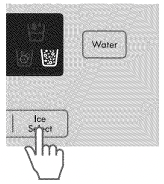
CAUTION: The control display is operated by touch. Excessive moisture on the display may cause a malfunction. Please keep display clean and dry.
WARNING: The dispenser will not work if any door is left open.
Ultra Ice
- When you touch the Ultra Ice button, the graphic [
 ] will light up in the display and will remain on for 24 hours. It will automatically shut off after 24 hours have passed. You can stop this function manually by touching the button one more time.
] will light up in the display and will remain on for 24 hours. It will automatically shut off after 24 hours have passed. You can stop this function manually by touching the button one more time. - This function increases both icemaking and freezing capabilities.
Filter Reset
- When the water filter indicator (
 ) turns on, you have to change the water filter. After changing the filter, press and hold the Ultra Ice (Filter Reset) button for 3 seconds to turn the indicator light off. You need to change the water filter approximately every 6 months.
) turns on, you have to change the water filter. After changing the filter, press and hold the Ultra Ice (Filter Reset) button for 3 seconds to turn the indicator light off. You need to change the water filter approximately every 6 months.
Light / Light Sensor
- If the light is set to "Auto" mode, dispenser light will automatically turn on and off according to the brightness of the room as detected by the light sensor.
Energy Saver
- Press and hold the Energy Saver button for at least 3 seconds to activate or deactivate the function.
- This function deactivates heaters used to reduce excess exterior moisture and is recommended for increased energy savings.
- The energy saving function is also recommended for periods of time when the doors will not be opened, such as vacations.
Door Alarm
- When power is connected to the refrigerator, the door alarm is initially set to
 (ON) and the door alarm display will show
(ON) and the door alarm display will show  (ON).
(ON).
When you press the  button, the display will change to
button, the display will change to  (OFF) and the door alarm function will be deactivated.
(OFF) and the door alarm function will be deactivated.
- When either the refrigerator or the freezer door is left open for more than 60 seconds, the alarm tone will sound to let you know the door is open.
- When you close the door, the door alarm will stop.
Lock
- When power is initially connected to the refrigerator, the Lock function is off.
- If you want to activate the Lock function to lock other buttons, press and hold the
 button for 3 seconds or more. The
button for 3 seconds or more. The  sign will be displayed and the Lock function is now enabled.
sign will be displayed and the Lock function is now enabled. - When the Lock function is activated no other buttons will work. The dispenser pad is also deactivated.
- To disable the Lock function, press and hold the
 button for 3 seconds or more.
button for 3 seconds or more.
Temperature Mode (°F <->°C)
- If you want to convert °F to °C or vice versa, press and hold the
 button and
button and button at the same time for 5 seconds or more.
button at the same time for 5 seconds or more.
Power Saving Mode
- When the refrigerator is in the Power Saving Mode, the display will remain off until a door is opened or a button is pressed. Once on, the display will remain on for 20 seconds.
- To deactivate the Power Saving Mode, press the Freezer Temp and Ultra Ice buttons at the same time and hold them for 5 seconds until the tone sounds.

CAUTION
Demo Mode (Retail Stores)
The Demo Mode disables all cooling in the refrigerator and freezer sections to conserve enegy while on display in a retail store.
1.To activate:
With the refrigerator door opened, press and hold the Refrigerator Temp and Ultra Ice buttons at the same time for 5 seconds. The control panel will beep to confirm that the Demo Mode is activated.
2. To deactivate:
With the refrigerator door opened, press and hold the Refrigerator Temp and Ultra Ice buttons at the same time for 5 seconds. The control panel will beep to confirm that the Demo Mode is deavtivated.
Caution When Closing the Door
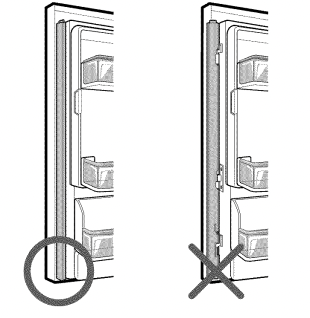
CAUTION
To reduce the risk of door scratches and breaking the door mullion, please make sure that the refrigerator door mullion is always folded in.
If moisture gathers on the refrigerator door mullion at any point, turn off the Energy Saver mode until the issue is resolved.
IN-DOOR ICE BIN
CAUTION
Keep hands and tools out of the ice compartment door and dispenser chute. Damage or personal injury may result.
The icemaker will stop producing ice when the ice bin is full. If you need more ice, empty the ice bin into the extra ice bin in the freezer compartment.
During use, the ice can become uneven causing the icemaker to misread the amount of ice cubes and stop producing ice. Shaking the ice bin to level the ice within it can reduce this problem.
NOTE: Storing cans or other items in the ice bin will damage the icemaker.
Keep the ice compartment door closed tightly. If the ice compartment door is not closed tightly, the cold air in the ice bin will freeze food in the refrigerator compartment. This could also cause the icemaker to not produce ice.
NOTE: If the On/Off switch on the icemaker is set to Off (O) for an extended time, the ice compartment will gradually warm up to the temperature of the refrigerator compartment. To prevent ice cubes from melting and leaking from the dispenser, ALWAYS empty the ice bin when the icemaker is set to Off (O) for more than a few hours.

CAUTION When handling the ice bin, keep hands away from the blade area to avoid personal injury.
1. Pull or push the door handle to open or close the Ice Compartment.

2. To remove the in-door ice bin, grip the front handle, slightly lift the lower part, and slowly pull out the bin as shown.
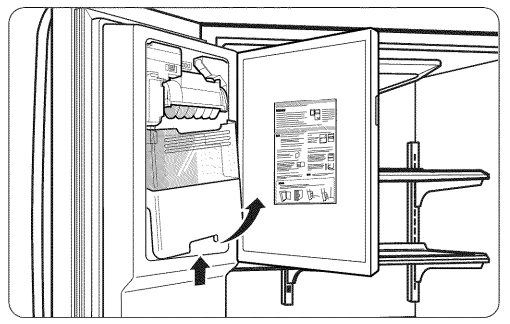
3. To reinstall the in-door ice bin, slightly slant the bin during replacement to avoid contact with the icemaker.
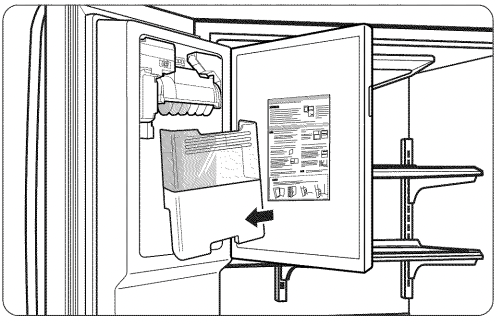
4. Avoid touching the Ice-detecting sensor when replacing the ice bin. See the label on the ice compartment door for details.
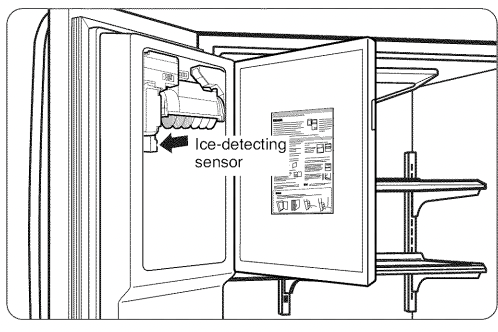
ADJUSTING CONTROL SETTINGS
Give the refrigerator time to cool down completely before making final adjustments. It is best to wait 24 hours before doing this. The initial settings mentioned in SETTING THE CONTROLS section should be correct for normal household refrigerator use. The controls are set correctly when milk or juice is as cold as you like and when ice cream is firm.
The refrigerator control functions as the thermostat for the entire appliance (refrigerator and freezer sections). The colder the setting, the longer the compressor will run to keep the temperature colder. The freezer control adjusts the cold air flow from the freezer to the refrigerator. Setting the freezer control to a lower temperature keeps more cold air in the freezer compartment to make it colder.
If you need to adjust temperatures in the refrigerator or freezer, start by adjusting the refrigerator and allow 24 hours for the temperatures to stabilize. If it is still too warm or too cold, then adjust the freezer control.
Always remember to wait at least 24 hours between adjustments.
|
CONDITIONS REASON: |
RECOMMENDED ADJUSTMENT: |
|
Set REFRIGERATOR control one degree lower C or two degrees lower F, wait 24 hours, then re- check |
|
FREEZER section too warm/ice not made fast enough
|
Set FREEZER control one degree lower C or two degrees lower F, wait 24 hours, then re-check
Move items out of airstream |
|
REFRIGERATOR section too cold — Controls not set correctly for your conditions |
Set REFRIGERATOR control one degree higher C or two degrees higher F, wait 24 hours, then re-check |
|
FREEZER section too cold — Controls not set correctly for your conditions |
Set FREEZER control one degree higher C or two degrees higher F, wait 24 hours, then re-check |
FOOD STORAGE GUIDE
Wrap or store food in the refrigerator in airtight and moisture-proof material unless otherwise noted. This prevents food odor and taste transfer throughout the refrigerator. For dated products, check date code to ensure freshness.
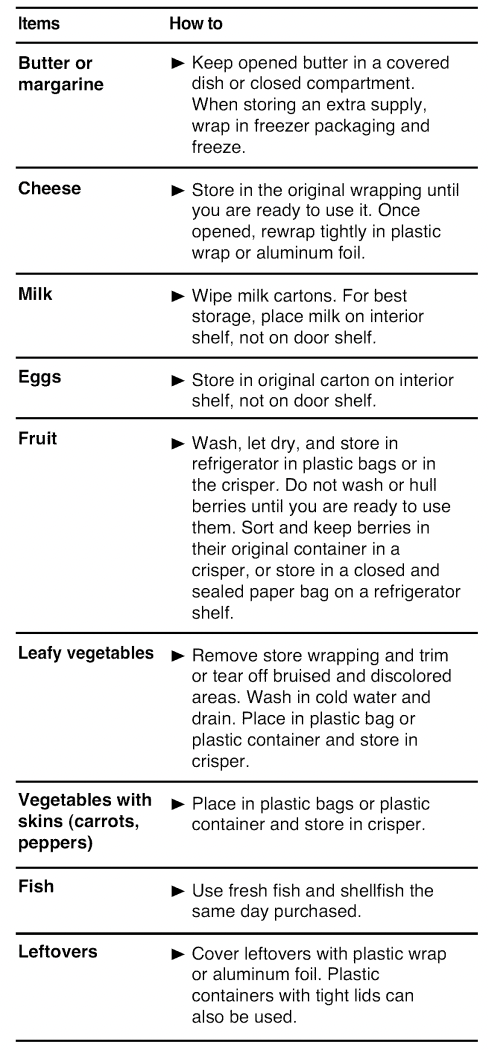
STORING FROZEN FOOD
NOTE: For further information about preparing food for freezing or food storage times, check a freezer guide or a reliable cookbook.
Packaging
Successful freezing depends on correct packaging. When you close and seal the package, it must not allow air or moisture in or out. If it does, you could have food odor and taste transfer throughout the refrigerator and also dry out frozen food.
Packaging recommendations:
- Rigid plastic containers with tight-fitting lids
- Straight-sided canning/freezing jars
- Heavy-duty aluminum foil
- Plastic-coated paper
- Non-permeable plastic wraps
- Specified freezer-grade self-sealing plastic bags
Follow package or container instructions for proper freezing methods.
Do not use
- Bread wrappers
- Containers without tight lids
- Wax paper or wax-coated freezer wrap
- Thin, semi-permeable wrap
CAUTION: Do not keep beverage cans or plastic food containers in the freezer compartment. They may break or burst if they freeze.
Freezing
Your freezer will not quick-freeze any large quantity of food. Do not put more unfrozen food into the freezer than will freeze within 24 hours (no more than 2 to 3 lbs of food per cubic foot of freezer space). Leave enough space in the freezer for air to circulate around packages. Be careful to leave enough room at the front so the door can close tightly.
Storage times will vary according to the quality and type of food, the type of packaging or wrap used (airtight and moisture-proof) and the storage temperature. Ice crystals inside a sealed package are normal. This simply means that moisture in the food and air inside the package have condensed, creating ice crystals.
NOTE: Allow hot foods to cool at room temperature for 30 minutes, then package and freeze. Cooling hot foods before freezing saves energy.
REFRIGERATOR SECTION
WATER DISPENSER
To dispense cold water, push on the dispenser switch with a glass.

Press down on either of the front corners to remove the tray.

WARNING: Do not put your fingers up the ice chute opening. Doing so can result in severe injury.
CAUTION: Do not dispense ice into fine china or crystal glasses. China or crystal can break.
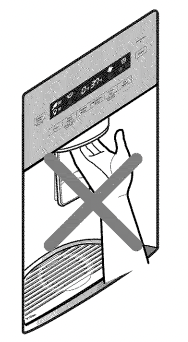
REFRIGERATOR SHELVES
The shelves in your refrigerator are adjustable to meet your individual storage needs. Your model may have glass or wire shelves.
Storing similar food items together in your refrigerator and adjusting the shelves to fit different heights of items will make finding the exact item you want easier; it will also reduce the amount of time the refrigerator door is open, saving energy.
IMPORTANT: Do not clean glass shelves with warm water while they are cold. Shelves may break if exposed to sudden temperature changes or impact, such as bumping. For your protection, glass shelves are made with tempered glass, which will shatter into small pebble-sized pieces.
NOTE: Glass shelves are heavy. Use special care when removing them to avoid dropping them.
Adjusting Shelves
Remove shelves from the shipping position and replace shelves in the position you want.
- To remove a shelf—Tilt up the front of the shelf in the direction of 1 and lift it in the direction of 2. Pull the shelf out.
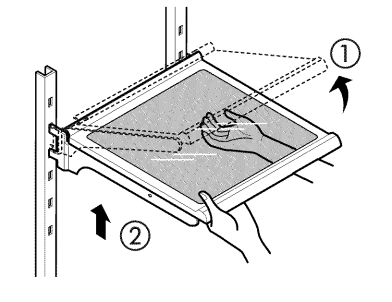
- To reinstall a shelf— Tilt the front of the shelf up and guide the shelf hooks into the slots at a desired height. Then lower the front of the shelf so that the hooks drop into the slots.
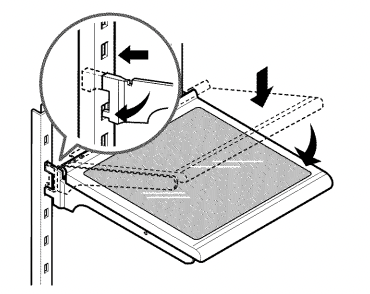
CAUTION: Make sure that shelves are level from one side to the other. Failure to do so may result in the shelf falling or spilling food.
Folding Shelf
You can store taller items such as a gallon container or bottles by simply pushing the front half of shelf underneath back half of shelf. Pull toward you to return to a full shelf.

HUMIDITY CONTROLLED CRISPER
The crispers provide fresher-tasting fruit and vegetables by letting you easily control humidity inside the drawer.
You can control the amount of humidity in the moisture-sealed crispers. Adjust the control to any setting between VEGETABLE and FRUIT.
- VEGETABLE keeps moist air in the crisper for best storage of fresh, leafy vegetables.
- FRUIT lets moist air out of the crisper for best storage of fruits.
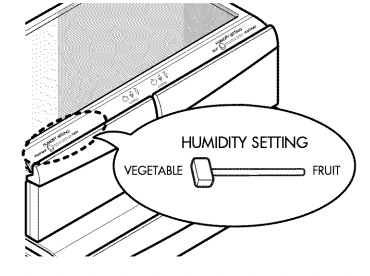
REMOVING HUMIDITY CONTROLLED CRISPER
- To remove, pull the drawer out to full extension.
- Lift the front of the crisper up, then pull it straight out.
- To install, slightly tilt up the front and insert the drawer into the frame and push it back into place.

To remove the glass
- Lift up the glass under the crisper cover.
- Pull the glass up and out.
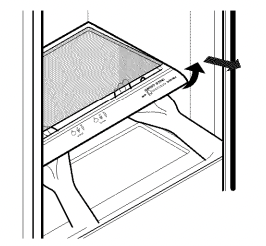
TEMPERATURE CONTROLLED PANTRY DRAWER
The Temperature Controlled Pantry Drawer provides storage space with a variable temperature control, that can keep the compartment colder than the refrigerator section. This drawer can be used for large party trays, deli items, and beverages. (This drawer should not be used for vegetables that require high humidity).
Press the Select button to choose between Meats, Deli, and Produce.
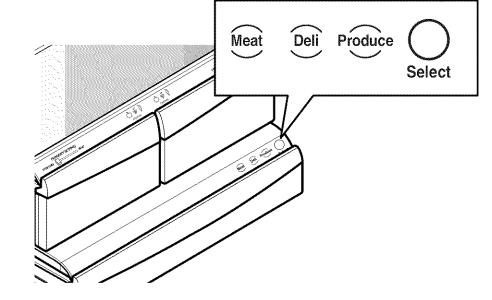
MODULAR DOOR BIN
The door bins are removable for easy cleaning and adjusting.
- To remove the bin, simply lift the bin up and pull straight out.
- To replace the bin, slide it in above the desired support button and push down until it snaps into place.
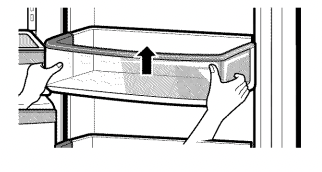
DAIRY BIN
- To remove the dairy bin, simply lift it and pull straight out.
- To replace the dairy bin, slide it into place and push down until it stops

NOTE: The dairy bin will only fit in the top space on the right-hand door.
FREEZER SECTION
EXTRA ICE BIN
- To remove the ice bin from the upper drawer, pull out the drawer as far as possible.
- Gently lift and pull out the ice bin.
- To install, pull out the drawer as much as possible and set the ice bin in its correct position, then push in the drawer.
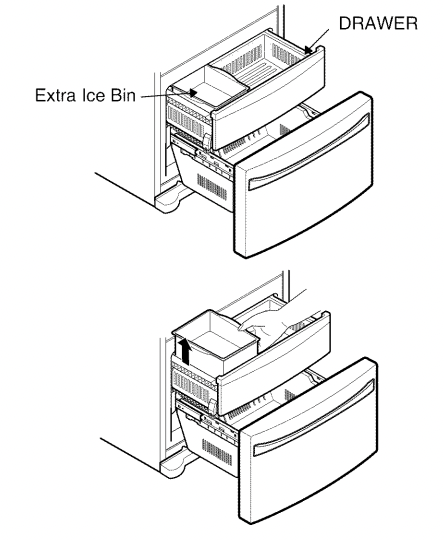
CAUTION: Pinch hazard! Keep hands and feet clear of the bottom of the door when opening and closing.
DURABASE
- To remove the Durabase, push it to the back as much as possible. Tilt up the front of the Durabase and pull straight out.
- To install, insert the Durabase in rail assembly.
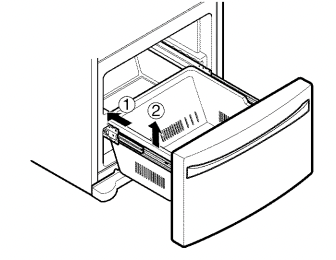
DURABASE DIVIDER
The Durabase divider allows you to organize the Durabase area into sections.
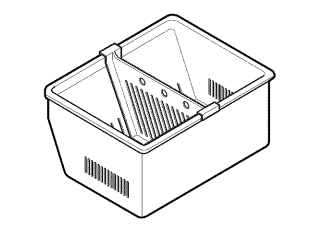
WARNING: If the Durabase divider is removed, there is enough open space for children or pets to crawl inside.
To prevent accidental child and pet entrapment or suffocation risk, DO NOT allow them to touch or go near the freezer drawer.
PULLOUT DRAWER
1. To remove, pull the drawer out to full extension. Lift the front of the drawer up, then pull it straight out.
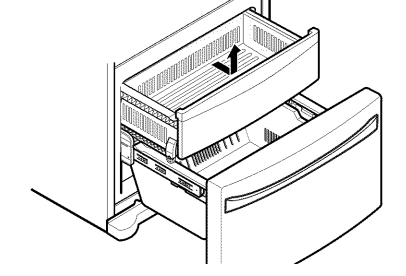
2. To install, slightly tilt up the front and insert the drawer into the frame and push it back into place.
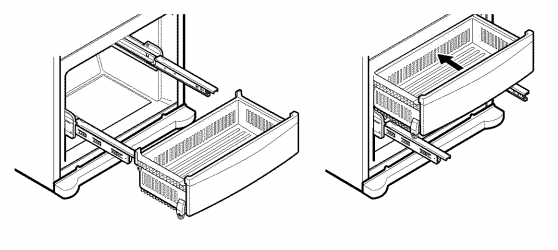
FILTER
FILTER
It is recommended that you replace the filter approximately every 6 months, when the water filter indicator ( ) turns on, or when the ice and water dispenser noticeably decreases output.
) turns on, or when the ice and water dispenser noticeably decreases output.

1.Remove the old filter.
- Press the push button to open the filter cover.
NOTE: Replacing the filter causes a small amount of water (around 1 oz. or 25 cc) to drain. Place a cup under the filter hole to catch any waste.

- Pull the filter downward and pull out.
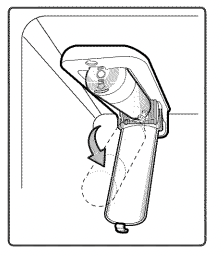
2. Replace with a new filter.
See other models: 66515732 BU4022 40584106410 11020022011 11024982300
Take the new filter out of it's packaging and remove the protective cover from the o-rings. With filter "tabs" in the horizontal position, push the new filter into the manifold hole until it stops.
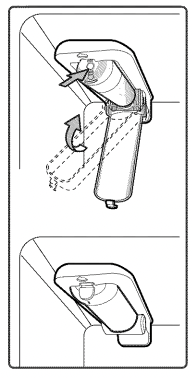
3. After replacing the filter, flush 2.5 gallons through filter before use (flush for approximately 5 minutes) and check the filter for leaks.
To reset the water filter status display and indicator light, press and hold the Ultra Ice (Fliter Reset) button for at least 3 seconds.
4. Filter Bypass Plug Keep the filter bypass plug.
You MUST use the filter bypass plug when a replacement filter cartridge is not available.
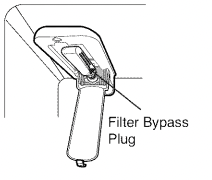
CAUTION: DO NOT operate refrigerator without filter or filter plug installed.
NOTE: To purchase replacement water filter, visit your Sears store or 1-800-4MY- HOME.
CARE AND CLEANING
WARNING Explosion Hazard Use non-flammable cleaner. Failure to do so can result in death, explosion, or fire.
Both the refrigerator and freezer sections defrost automatically. However, clean both sections about once a month to prevent odors. Wipe up spills immediately.
GENERAL CLEANING TIPS
- Unplug refrigerator or disconnect power.
- Remove all removable parts, such as shelves, crispers, etc. Refer to sections in Using Your Refrigerator for removal instructions.
- Use a clean sponge or soft cloth and a mild detergent in warm water. Do not use abrasive or harsh cleaners.
- Hand wash, rinse and dry all surfaces thoroughly.
- Plug in refrigerator or reconnect power.
OUTSIDE
Waxing external painted metal surfaces helps provide rust protection. Do not wax plastic parts. Wax painted metal surfaces at least twice a year using appliance wax (or auto paste wax). Apply wax with a clean, soft cloth.
For products with a stainless steel exterior, use a clean sponge or soft cloth and a mild detergent in warm water. Do not use abrasive or harsh cleaners. Dry thoroughly with a soft cloth.
INSIDE WALLS (allow freezer to warm up so the cloth will not stick)
To help remove odors, you can wash the inside of the refrigerator with a mixture of baking soda and warm water. Mix 2 tablespoons baking soda to 1 quart of water (26 g soda to 1 liter water.) Be sure the baking soda is completely dissolved so it does not scratch the surfaces of the refrigerator.
CAUTION: While cleaning the inside, do not spray water.
DOOR LINERS AND GASKETS
Do not use cleaning waxes, concentrated detergents, bleaches, or cleaners containing petroleum on plastic refrigerator parts.
PLASTIC PARTS (covers and panels)
Do not use window sprays, abrasive cleansers, or flammable fluids. These can scratch or damage the material.
CONDENSER COILS
Use a vacuum cleaner with an attachment to clean the condenser cover and vents.
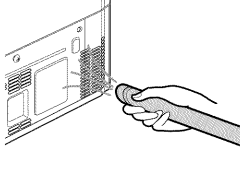
LIGHT BULB REPLACEMENT
WARNING Electrical Shock Hazard
Before replacing a Light Bulb, either unplug the refrigerator or turn off power at the circuit breaker or fuse box.
NOTE: Refrigerator light is LED interior lighting and service should only be perfomed by a qualified technician.
Change Freezer Compartment Light Bulb
- Unplug refrigerator power cord form outlet.
- Remove the screw using a Phillips screwdriver.
- Grasp the light cover, pull the cover downward.
- Make sure the bulb is cool to the touch. Rotate the bulb counterclockwise to remove.
- Replace with a new 60-watt appliance bulb.
- Insert tabs on back of cover into slots in freezer ceiling. Push cover up to snap front into place.
- Tighten the screw using a Phillips screwdriver.
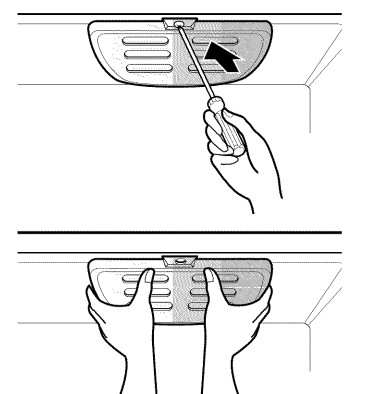
CAUTION: DO NOT place fingers inside of cover. Lamp may be hot.
- When you are finished, reconnect the refrigerator to the electrical source and reset the controls.
POWER INTERRUPTIONS
- If the power will be out for 24 hours or less, keep all refrigerator doors closed to help foods stay cold and frozen.
- If the power will be out for more than 24 hours, remove all frozen food and store it in a frozen food locker.
WHEN YOU GO ON VACATION
If you choose to leave the refrigerator on while you are away, follow these steps to prepare your refrigerator before you leave.
- Use up any perishables and freeze other items.
- Turn off icemaker and empty the ice bin.
If you choose to turn the refrigerator off before you leave, follow these steps.
- Remove all food from the refrigerator.
- Clean refrigerator, wipe it and dry well.
- Tape rubber or wood blocks to the tops of both doors to prop them open far enough for air to get in. This stops odor and mold from building up.
WHEN YOU MOVE
When you are moving your refrigerator to a new home, follow these steps to prepare it for the move.
- Remove all food from the refrigerator and pack all frozen food in dry ice.
- Unplug the refrigerator.
- Clean, wipe and dry thoroughly.
- Take out all removable parts, wrap them well and tape them together so they do not shift and rattle during the move. Refer to sections in Using your Refrigerator for removable instructions.
- Depending on the model, raise the front of the refrigerator so it rolls more easily OR screw in the leveling legs all the way so they do not scrape the floor. See the Door Closing section.
- Tape the doors shut and tape the power cord to the refrigerator cabinet.
When you get to your new home, put everything back and refer to the Installing Your Refrigerator section for preparation instructions.
TROUBLESHOOTING GUIDE
UNDERSTANDING SOUNDS YOU MAY HEAR
Your new refrigerator may make sounds that your old one did not make. Because the sounds are new to you, you might be concerned about them. Most of the new sounds are normal. Hard surfaces, like the floor, walls and cabinets, can make the sounds seem louder than they actually are. The following list describes the kinds of sounds and what may be making them.
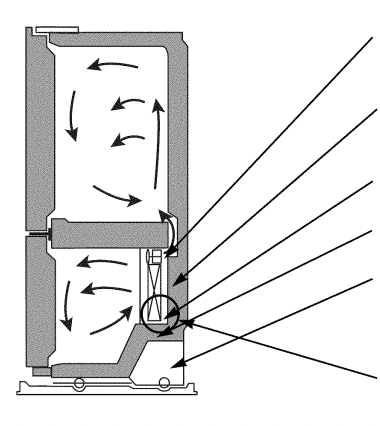
- A clicking noise may come from the electronic control switching the cooling system on and off.
- Rattling noises may come from the flow of refrigerant, the water line, or items stored on top of the refrigerator.
- Your refrigerator is designed to run more efficiently to keep your food items at the desired temperature. The high efficiency compressor may cause your new refrigerator to run longer than your old one, but is still more energy efficient than previous models. While running, you may hear a pulsating or high-pitched sound, this is normal.
- You may hear the evaporator fan motor circulating the air through the refrigerator and freezer compartments.
- As each cycle ends, you may hear a gurgling sound due to the refrigerant flowing in your refrigerator.
- Contraction and expansion of the inside walls may cause a popping noise.
- Water dripping on the defrost heater during a defrost cycle may cause a sizzling sound.
- You may hear air being forced over the condenser by the condenser fan.
- You may hear water running into the drain pan during the defrost cycle.
- You can hear the noise occurring from the ice compartment fan in the freezer or the left side of the refrigerator when doors are open.
REFRIGERATOR DOES NOT OPERATE
|
Check if... |
Then... |
| The power supply cord is unplugged. | Firmly plug the cord into a live outlet with proper voltage. |
| A household fuse has blown or circuit breaker tripped. | Replace the fuse or reset the circuit breaker. Check that the house circuit is not overloaded. |
| Refrigerator is in the defrost cycle. | Wait about 30 minutes for defrost cycle to end. |
|
Refrigerator is in Store salesfloor Demonstration mode.
|
The refrigerator control has been put into the store Demo (Demonstration) Mode. The Demonstration Mode disables the cooling system, only lamps and display work normally. To disable open one door, then press Ultra Ice and Refrigerator Temp buttons at the same time for 5 seconds. You will see the previous value setting you had on display when Demo Mode is deactivated. |
LIGHTS DO NOT WORK
|
Check if... |
Then... |
| The power supply cord is unplugged. | Firmly plug the cord into a live outlet with proper voltage. |
| Light bulb is loose in the socket. | Unplug the refrigerator. Gently remove the bulb and reinsert. Then plug in refrigerator and reset the refrigerator control. |
| Light bulb has burned out. | Replace with an appliance bulb of the same wattage, size and shape available at your local hardware store. (See the Changing the Light Bulb(s} section on pages 32-33.) Unplug the refrigerator prior to replacement. |
VIBRATION OR RATTLING NOISE
|
Check if... |
Then... |
| The refrigerator is not resting solidly on the floor. | Floor is weak or uneven or leveling legs need adjusting. See Installation section on pages 9 and 17. |
COMPRESSOR MOTOR SEEMS TO RUN TOO MUCH
|
Check if... |
Then... |
| The refrigerator that was replaced was an older model. | Modern refrigerators with more storage space require more operating time. Even though this refrigerator may run more than your older one it will still use less energy. |
| The room temperature is hotter than normal. | The motor will run longer under warm conditions. At normal room temperatures, expect your motor to run about 40% to 80% of the time. Under warmer conditions, expect it to run even more often. |
| The door is opened often or a large amount of food has just been added. | Adding food and opening the door warms the refrigerator. It is normal for the refrigerator to run longer in order to cool the refrigerator back down. See the Food Storage Guide section on page 22. In order to conserve energy, try to get everything you need out of the refrigerator at once, keep food organized so it is easy to find and close the door as soon as the food is removed. |
| The refrigerator was recently plugged in and the refrigerator control was set correctly. | The refrigerator will take up to 24 hours to cool completely. |
| The refrigerator control is not set correctly for the surrounding conditions. | See the Adjusting Control Settings section on page 21. |
| The doors are not closed completely. | Push the doors firmly shut. If they will not shut all the way, see Doors will not close completely below. |
| The back cover is dirty. | A dirty back cover prevents air transfer and makes the motor work harder. Clean the back cover. Refer to the Care and Cleaning section on page 32-33. |
DOORS WILL NOT CLOSE COMPLETELY
|
Check if... |
Then... |
|
The refrigerator is not level. |
See Leveling and Door Alignment section on page 17. |
|
Food packages are blocking the door open. |
Rearrange food containers to clear door and door shelves. |
|
The ice bin, crisper cover, pans, shelves, door bins or baskets are out of position. |
Push bins all the way in and put crisper cover, pans, shelves and baskets into their correct positions. See the Using Your Refrigerator section on pages 18—27. |
|
The gaskets are sticking. |
Clean the gaskets and the surfaces that they touch. Rub a thin coat of appliance polish or kitchen wax on the gaskets after cleaning. |
|
The refrigerator wobbles or seems unstable. |
Level the refrigerator. Refer to the Leveling and Door Alignment section on page 17. |
|
The doors were removed during product installation and not properly replaced. |
Remove and replace the doors according to the Removing and Replacing Refrigerator handles and doors section on pages 11—16, or call a qualified service technician. |
FROST OR ICE CRYSTALS ON FROZEN FOOD
|
Check if... |
Then... |
|
The door is not closing properly. |
See Doors will not close completely above. |
|
The door is opened often. |
When the door is opened, warm, humid air is allowed in the freezer, resulting in frost. |
ICE HAS BAD TASTE OR ODOR
|
Check if... |
Then... |
|
The icemaker was recently installed. |
Discard the first few batches of ice to avoid discolored or bad tasting ice. |
|
The ice has been stored for too long. |
Throw away old ice and make a new supply. |
|
The food has not been wrapped tightly in either compartment. |
Rewrap foods since odors may migrate to the ice if food is not wrapped properly. |
|
The water supply contains minerals such as sulfur. |
A filter may need to be installed to eliminate taste and odor problems. |
|
The interior of refrigerator needs cleaning. |
See Care and Cleaning section on pages 32-33. |
|
Ice storage bin needs cleaning. |
Empty and wash bin. Discard old cubes. |
THERE IS WATER IN THE DEFROST DRAIN PAN
|
Check if... |
Then... |
|
The refrigerator is defrosting. |
The water will evaporate. It is normal for water to drip into the defrost pan. |
|
It is more humid than normal. |
Expect that the water in the defrost pan will take longer to evaporate. This is normal when it is hot or humid. |
THE REFRIGERATOR SEEMS TO MAKE TOO MUCH NOISE
|
Check if... |
Then... |
| The sounds may be normal for your refrigerator. | Refer to the Understanding Sounds You May Hear section on page 39. |
THE ICEMAKER IS NOT PRODUCING ICE OR NOT ENOUGH ICE
|
Check if... |
Then... |
|
New installation. |
Wait 24 hours after ice maker installation for ice production to begin. Wait 72 hours for full ice production. |
|
The refrigerator is not connected to a water supply or the supply shutoff valve is not turned on. |
Connect refrigerator to the water supply and turn water shutoff valve fully open. |
|
Reverse osmosis water filtration system is connected to your cold water supply. |
Reverse osmosis filtration systems can reduce the water pressure below the minimum amount (40 psi) and result in icemaker issues. |
|
Kink in the water source line. |
A kink in the line can reduce water flow. Straighten the water source line. |
|
Large amount of ice recently has been removed. |
Allow 24 hours for ice maker to produce more ice. NOTE: An extra ice bucket is provided in the freezer section for additional storage. |
|
The icemaker is not turned on. |
Locate the icemaker on/off switch and confirm it is in the On (I) position. |
|
There is something on the ice-detecting sensor. |
Foreign substances or frost on the ice-detecting sensor can interrupt ice production. Make sure the sensor area is clean at all times for proper operation. |
|
The temperature setting for the freezer is too warm. |
Below 0°F is the recommended temperature for the freezer compartment for normal ice production. If the freezer temperature is warmer, ice production will be affected. |
|
The doors are opened often. |
If the doors of the unit are opened often, the cold air will escape which will prevent the unit from maintaining the set temperature. Lowering the temperature can help, as well as not opening the doors as frequently. |
|
The doors are not closing properly. |
If the doors are not properly closed, ice production will be affected. |
|
The ice compartment door is not closing properly. |
If the ice compartment door is not properly closed, ice production will be affected. Make sure ice compartment door is closed for proper operation. |
|
Ultra Ice is not selected. |
With this option, the cold air in the compartment is increased as is ice production. |
NOT DISPENSING ICE
|
Check if... |
Then... |
|
All the doors are not closed completely. |
Ice will not dispense if any of the refrigerator doors are left open. |
|
The dispenser display is locked. |
Press and hold the Lock ( |
|
Ice is not selected on the dispenser. |
The dispenser can be set for ice or water. Make certain that the control panel is set for the proper operation. Press the dispenser button on the control panel to cycle through the ice and water options. |
|
The ice dispenser is not used often. |
Infrequent use of the ice dispenser will cause the cubes to stick together over time, which will prevent them from properly dispensing. Check the ice bin for ice cubes clumping/sticking together. If they are, break up the ice cubes to allow for proper operation. |
|
Ice bin is not installed correctly. |
Be sure to install the ice bin firmly into position. |
|
New installation. |
Wait 24 hours after ice maker installation for ice production to begin. Wait 72 hours for full ice production. |
|
Ice cubes are stuck in the delivery chute. |
Use a plastic utensil to clear the delivery chute. |
|
The ice dispenser is stalling while dispensing “crushed” ice. |
Change the ice button from “crushed” to “cubed”. If cubed ice dispenses correctly, depress the button for “crushed” ice and begin dispensing again. |
DISPENSING WARM WATER
|
Check if... |
Then... |
|
New installation. |
Allow 24 hours after installation for the water supply to cool completely. |
|
The water dispenser has been recently used. |
The unit has its own water tank inside. The water storage capacity is 12 oz. (345 ml) of cold water. |
|
The refrigerator is connected to a hot water line. |
Make sure the refrigerator is connected to a cold water pipe. |
NOT DISPENSING WATER
|
Check if... |
Then... |
|
The dispenser panel is locked. |
Press and hold the Lock ( |
|
New installation. |
Flush and fill the water system. |
|
Refrigerator or freezer doors are not closed properly. |
Water will not dispense if any of the refrigerator doors are left open. |
|
The refrigerator is not connected to a water supply or the supply shutoff valve is not turned on. |
Connect refrigerator to the water supply and turn water shutoff valve fully open. |
|
The water pressure is less than 40 psi. |
The water pressure to the home affects the flow from the dispenser. |
|
Home filter or reverse osmosis system is used. |
This can decrease water pressure. It is recommended not to connect the supply line to a reverse osmosis system for optimal operation. |
|
The dispenser is not set for water dispensing. |
The dispenser can be set for ice or water. Make certain that the control panel is set for the proper operation. Press the dispenser button on the control panel to cycle through the ice and water options. |
|
Water filter needs to be changed. |
The filter should be changed every 6 months or more often depending on usage. The filter can become blocked over time with foreign particles and reduce the water pressure. |
THE DOORS ARE DIFFICULT TO OPEN
|
Check if... |
Then... |
|
The gaskets are dirty or sticky. |
Clean gaskets and the surfaces that they touch. Rub a thin coat of appliance polish or kitchen wax on the gaskets after cleaning. |
|
The door is reopened within a short time after having been opened. |
When you open the door, warmer air enters the refrigerator. As the warm air cools, it can create a vacuum. If the door is hard to open, wait 5 minutes to allow the air pressure to equalize, then see if it opens more easily. |
TEMPERATURE IS TOO WARM OR THERE IS INTERIOR MOISTURE BUILDUP
|
Check if... |
Then... |
|
The air vents are blocked. Cold air circulates from the freezer to the fresh food section and back again through air vents in the wall dividing the two sections. |
Locate air vents by using your hand to sense airflow and move all packages that block vents and restrict airflow. (See air flow diagram below). |
|
The doors are opened often. |
When the door is opened, warm humid air is allowed into the refrigerator. The more the door is opened, the faster the humidity builds up, and the more warm air the refrigerator must cool. In order to keep the refrigerator cool, try to get everything you need out of the refrigerator at once, keep food organized so it is easy to find and close the door as soon as the food is removed. |
|
The control is not set correctly for the surrounding conditions. |
Refer to the Setting the Controls section on page 18. Wait 24 hours for temperatures to stabilize or even out. If the temperature is too cold or too warm, change the setting one increment at a time. |
|
A large amount of food has just been added to the refrigerator or freezer. |
Adding food warms the refrigerator. It can take a few hours for the refrigerator to return to normal temperature. |
|
The food is not packaged correctly. |
Wrap food tightly and wipe off damp containers prior to storing in the refrigerator to avoid moisture accumulation. If necessary, repackage food according to the guidelines in the Food Storage Guide section on page 22. |
|
The doors are not closing completely. |
See Doors will not close completely on page 41. |
|
The weather is humid. |
In humid weather, air carries moisture into the refrigerator when the doors are opened. |
|
A self-defrost cycle was completed. |
It is normal for droplets to form on the back wall after the refrigerator self-defrosts. |



